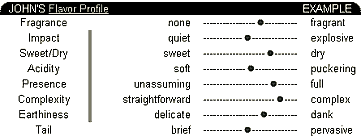|
WORKSHOP
Top Page
Level One
Level Two
Level Three 
Sake History
To learn more, visit:
Sake Knowledge
ARCHIVES
Newsletter Archive
Japan Times Archive
FREE NEWSLETTER
Click here to sign up
|
|
 Developing Your Palate Developing Your Palate
Judging Various Tastes
Keeping Notes
Sake may be new to the palates of many
, but in the end it is no more difficult to appreciate than wine. And, more than being a matter of natural talent (which certainly plays a part) it is a matter of experience.
In short, learning to taste and discern sake is a matter of two things: memory, and your ability to express yourself. Can you put into words (or feelings) what a sake smells and tastes like to you? And, can you
remember those images, words or feelings? This is really what is behind it all, and with practice, both of these skills can be attained and polished.
In doing this, perhaps the most important step is to take tasting notes. They do not have to be long, detailed, or even legible. There is no need
to organize them in some fancy notebook (although this is a great idea if you have the discipline) or even rewrite them later. Just make it a
habit to write a little something down on a piece of paper -- anything will do -- each time you taste a new sake. Writing something down -- anything -- helps the flavor and fragrance of each sake become firmly
associated with a word or description in your mind. This makes it easier to pick out next time.
Specifically what should your write down? Simply make an association
between the fragrance or various aspects of the flavor with something in the natural world. What does the fragrance remind you of? What food or flower or fruit, vegetable, herb, plant? Rubber? Paper? Something
burning? Not only will this help you identify, remember and associate more easily next time, it will also allow you to exercise your ability to express what your senses have perceived.

I have developed my own tasting chart, which is shown below. You are welcome to utilize this chart and its eight basic tasting parameters.

Some people prefer to express what they perceive in terms of patterns
or other non-taste sensations. Mouth feel, graininess, roughness or smoothness will click more for others. Some prefer describing physical patterns of how a flavor profile unfolds and develops across the palate.
Still other people use a combination of several of the above. Use whatever works, but the key is to make associations, and learn to remember them.
You will be amazed how well this works. Soon you will be recognizing and recalling sake flavor profiles, and knowing what works for you and what does not.
Although we speak of tasting a sake, 70 percent of the sensory input actually comes from your sense of smell. There are fragrances to be perceived before, during and after a sip; be sure to pay attention to the
quality and intensity (or lack thereof) of all of these. Also, as much as possible, strive to eliminate any semblance or preconceived notions as
to how a sake should taste. This is especially important if you have tasted it before. Naturally, blind tasting is best, but this is not always practical, nor the most fun way to go about things.

A couple more practical hints: when tasting seriously, learn to take in the same amount of liquid each time. This will allow the sake to be perceived by the various sensing areas of your tongue the same way
each time, rather than bombard your palate one time and starve it the next. Do not taste after eating strong flavored or spicy foods. Also, the
palate is significantly more sensitive when you are a little bit hungry, and understandably dull when you are on a full stomach. Plan accordingly. And take a small swig of water between tasting two or
more different sake. |
|
|
|